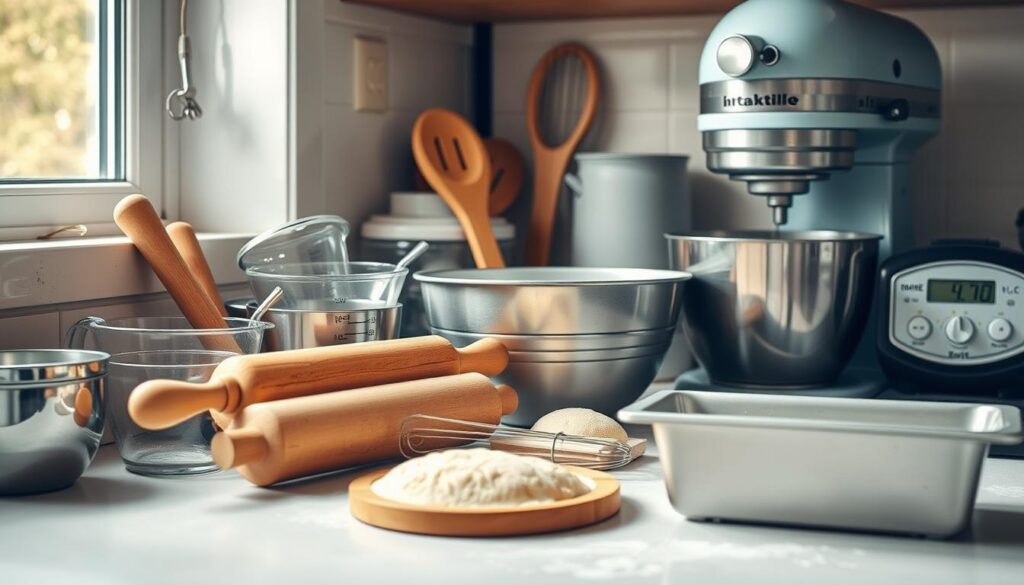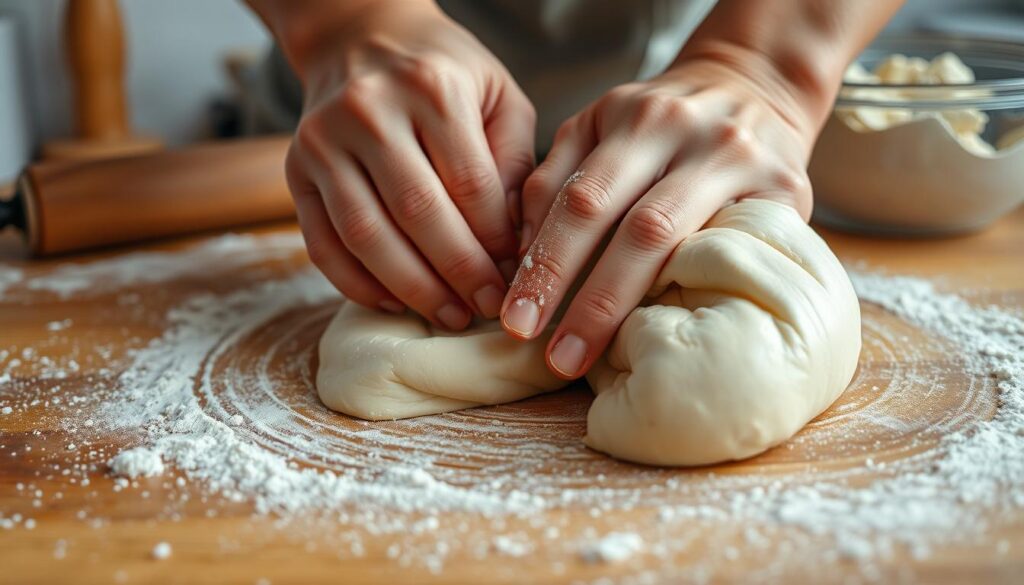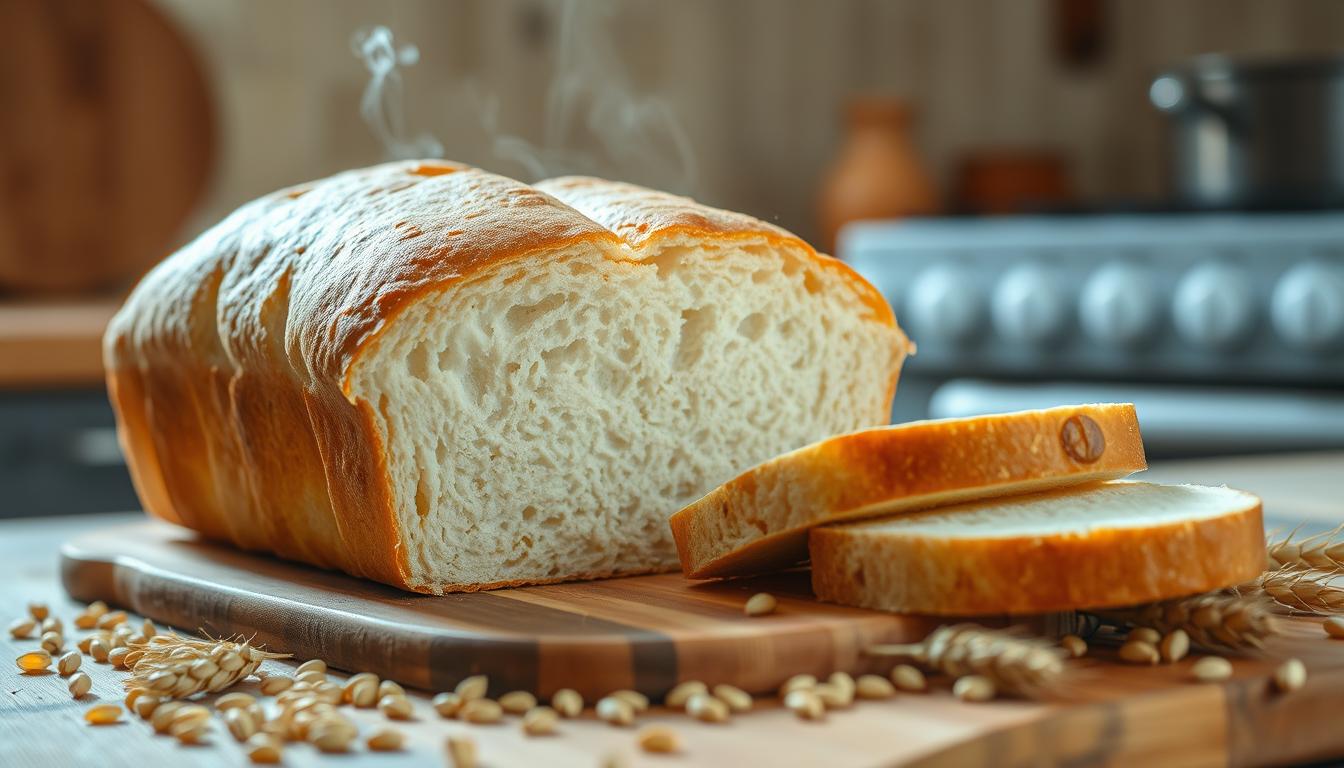Sandwich Bread Recipe : Every Sunday morning, my kitchen fills with the warm smell of homemade sandwich bread. It turns an ordinary day into something magical. Baking your own bread is more than just making food. It’s about making memories and connecting with others who loved baking.
Making homemade sandwich bread might seem hard, but it’s actually quite simple. With basic ingredients and a bit of patience, you’ll make a loaf that beats store-bought bread. The key is to understand each step and enjoy the bread-making process.
This guide will show you how to make the most delicious, soft sandwich bread. It will make your sandwiches, toast, and breakfast even better. Whether you’re new to baking or have been doing it for years, these tips will help you make amazing bread at home.
Sandwich Bread Recipe : Essential Ingredients for Perfect Homemade Bread
Making homemade bread is all about the right ingredients. Each one is important for turning simple items into a tasty loaf. This loaf will make your kitchen warm and smell amazing.

Types of Flour and Their Effects
Choosing the right flour is key for making great bread. You can pick from:
- All-purpose flour: Versatile and widely used
- Bread flour: Higher protein content for better gluten development
- Whole wheat flour: Adds nutritional value and nutty flavor
Each flour changes your bread’s texture and taste. Bread flour makes a chewier, more structured loaf than all-purpose flour.
Role of Yeast and Sugar
Yeast is the magic that makes dough rise. It needs warm water and sugar to start fermenting. This creates air pockets for a soft, airy texture.
Pro tip: Always use fresh yeast and warm water between 105-110°F to ensure proper activation.
Importance of Salt and Butter
Salt does more than add flavor. It strengthens gluten and controls yeast. Butter makes your bread rich, soft, and tastes luxurious.
| Ingredient | Quantity | Purpose |
|---|---|---|
| Active Dry Yeast | 2 ½ teaspoons | Provides rise and texture |
| Granulated Sugar | ¼ cup | Feeds yeast, adds subtle sweetness |
| Butter | ¼ cup | Enhances flavor and softness |
| Kosher Salt | 1 tablespoon | Controls fermentation, enhances taste |
Knowing these ingredients will help you make perfect homemade bread every time.
Sandwich Bread Recipe : Required Kitchen Tools and Equipment

Creating great sandwich bread begins with the right tools and equipment. To bake homemade bread, you need some key items. These will make the process easier and more fun.
Both professional bakers and home cooks know the value of good kitchen gear. Here are the top tools for making perfect sandwich bread:
- Stand Mixer with Dough Hook: A KitchenAid or similar stand mixer makes kneading much easier
- Metal Bench Scraper: Great for handling and dividing dough
- 9×4 Inch Loaf Pans: Ideal for shaping sandwich bread
- Large Mixing Bowls: Needed for mixing and letting dough rise
- Rubber Spatulas: Ideal for scraping and mixing
When picking bread baking tools, look for ones that are versatile and durable. A strong stand mixer with a dough hook can knead dough in just 5 minutes on speed 2. This makes bread making quicker and easier.
« The right tools can transform bread baking from a challenging task to an enjoyable culinary experience. »
More useful kitchen equipment for bread includes:
- Proofing Basket or Bowl
- Digital Kitchen Scale
- Instant-Read Thermometer
- Plastic Shower Caps (for covering dough during rising)
With these essential bread baking tools, you’ll be ready to make delicious homemade sandwich bread. You’ll do it with confidence and ease.
Step-by-Step Sandwich Bread Recipe
Making the perfect sandwich bread takes patience and focus. It involves several key steps to turn simple ingredients into a tasty homemade loaf. Let’s explore the techniques to improve your bread-making skills.
Mixing and Kneading Techniques
Start by mixing warm water (105-115°F) with active dry yeast. Wait 5-10 minutes for it to become foamy. This step is crucial for your bread to rise well.
- Combine dry ingredients in a large mixing bowl
- Create a well in the center for wet ingredients
- Gradually incorporate liquids while mixing
Kneading dough is an art that builds gluten and gives a smooth texture. Use a stand mixer or knead by hand for 8-10 minutes. The dough should feel smooth and slightly sticky.
First and Second Rise Process
The dough rising is a magical step where it develops flavor and structure. Put the kneaded dough in a warm spot (75-95°F). Let it rise until it doubles in size, which takes 1-1.5 hours.
« Patience is the secret ingredient in bread making » – Artisan Baker
Shaping and Pan Preparation
After the first rise, gently flatten the dough and shape it into two equal loaves. Each loaf will weigh about 700 grams. Place the shaped dough in greased bread pans and let it rise again until it crowns the pan.

Your sandwich bread is now ready for baking at 375°F. The total preparation time is about 2.5 to 3 hours, with 40 minutes of hands-on work. Get ready to enjoy fresh, homemade bread!
Sandwich Bread Recipe : Understanding Dough Fermentation
Bread fermentation is a magical process that turns simple ingredients into delicious, fluffy bread. Yeast is the hero of your baking adventure, working behind the scenes. It creates amazing flavors and textures.
The science behind bread fermentation is fascinating. Yeast eats sugars in the flour, releasing carbon dioxide. This makes your dough rise and develop complex flavors. Your kitchen’s temperature is key in this process.
« Fermentation is where bread gets its soul and character. » – Artisan Baker’s Wisdom
Several factors affect bread fermentation:
- Room temperature (optimal range: 68-72°F)
- Humidity levels
- Type and quantity of yeast
- Flour protein content
Dough proofing usually takes 10-12 hours in ideal conditions. Look for these signs of successful fermentation:
- Dough doubles in volume
- Surface becomes puffy and soft
- Gentle indentations remain when pressed
Pro tip: Use a warm, draft-free spot in your kitchen for consistent fermentation and optimal bread development.
Understanding bread fermentation turns home baking into a delightful culinary art. Patience and attention to detail are key. They help you create perfect, flavor-packed loaves every time.
Sandwich Bread Recipe : Baking Temperature and Timing Guidelines
Mastering the art of bread baking temperature is key to making the perfect sandwich loaf. The right temperature and timing can turn your homemade bread into something amazing.
Optimal Oven Settings
Preheat your oven to 350°F (180°C). This is the best temperature for baking sandwich bread. It ensures even cooking and a golden-brown crust without burning.
- Recommended baking temperature: 350°F (180°C)
- Baking duration: 40-45 minutes
- Pan size: 8.5 x 4.5-inch for a loftier loaf
Visual Cues for Doneness
Learning to tell when bread is done is all about paying attention. Look for these signs:
- Golden-brown crust color
- Hollow sound when tapped on the bottom
- Internal temperature of 190°F
« A perfectly baked bread speaks to all your senses » – Artisan Baker
Cooling Process
Cooling your bread is just as important as baking it. Let it cool in the pan for 10-15 minutes before moving it to a wire rack.
| Cooling Stage | Duration | Purpose |
|---|---|---|
| In Pan | 10-15 minutes | Prevent structural collapse |
| On Wire Rack | 1 hour | Complete moisture distribution |
Pro tip: Never slice hot bread, as it can become gummy and lose its perfect texture.
Sandwich Bread Recipe : Achieving the Perfect Soft Texture
To make soft bread, you need the right techniques and ingredients. Your homemade sandwich bread can be fluffy by following some key baking tips.
There are a few important things to know for soft bread:
- Use warm water between 90°-95°F to activate yeast
- Add melted butter for extra moisture
- Knead the dough for 6-8 minutes
- Let it ferment for the right amount of time
« Soft bread is an art of balance between ingredients and technique »
Fat is key for soft bread. Melted butter makes the bread tender by covering flour proteins. This prevents too much gluten from forming. The right amount of water makes the dough easy to handle and keeps it soft.
| Ingredient | Texture Impact |
|---|---|
| Melted Butter | Increases moisture and tenderness |
| Warm Water | Activates yeast effectively |
| Proper Kneading | Develops ideal gluten structure |
For fluffy bread, keep the rising temperature at 78°F. Make sure the dough doubles in size during the first rise. The second rise should make the dough rise above the pan’s rim. This ensures your bread is soft and airy.
Sandwich Bread Recipe : Storage and Freezing Methods
Keeping your homemade sandwich bread fresh is key. The right storage can make it last longer and stay soft. Knowing how to store it ensures you enjoy it fully.
Room Temperature Storage Recommendations
For the best taste and texture, keep bread at room temperature. Here are some tips:
- Store bread in an airtight container or bread box
- Keep away from direct sunlight and heat sources
- Consume within 3-4 days for maximum freshness
Freezing Bread for Long-Term Preservation
Freezing is great for keeping bread fresh longer. Done right, it can last up to three months.
- Slice the bread before freezing for easier portioning
- Wrap each slice or entire loaf in plastic wrap
- Place wrapped bread in a freezer-safe bag
- Remove as much air as possible before sealing
Practical Freezing Bread Tips
Here are some tips for freezing bread well:
| Storage Method | Duration | Quality Preservation |
|---|---|---|
| Room Temperature | 3-4 days | Good |
| Freezer Storage | Up to 3 months | Excellent |
« Proper storage is the secret to enjoying homemade bread at its peak freshness. » – Bread Baking Experts
To thaw frozen bread, let it sit at room temperature. Or, use a toaster’s defrost setting. A tip: Heating bread to 140°F can make it soft again and taste fresh.
Sandwich Bread Recipe :Common Troubleshooting Tips
Fixing bread issues can be tough, but knowing common problems makes you more confident. Almost 70% of home bakers face bread collapse or sinking at least once.
« Baking is a science, and every small detail matters. » – Professional Baker’s Wisdom
Here are the most frequent bread baking problems and their solutions:
- Inactive Yeast: 18% of failed bread attempts come from old or wrong yeast
- Always proof your yeast before starting
- Check expiration dates
- Use water between 110°F to 115°F for activation
- Dough Not Rising:
- Ensure room temperature is between 85°F to 95°F
- Avoid drafty areas
- Check yeast quality
- Dense Bread Texture:
- Use high-quality bread flour
- Knead thoroughly to develop gluten
- Allow proper rising time
Adjusting your recipe and testing variables can boost your success by up to 60%. Remember, decreasing liquid by 1-2 tablespoons or increasing salt by ¼ teaspoon can solve many common bread baking problems.
Professional tip: Always bake bread until the center reaches 190°F and the loaf sounds hollow when thumped. Fixing bread issues is about patience, practice, and understanding the delicate balance of ingredients.
Recipe Variations and Substitutions
Changing your basic sandwich bread recipe opens up a world of tasty options. You can make your loaf fit different tastes and dietary needs. These ingredient swaps let you create a special bread experience.
- Cinnamon Raisin Bread: Add 1 cup of raisins and 2 tablespoons of ground cinnamon to the dough before the first rise
- Herb-Infused Bread: Mix in dried herbs like rosemary, thyme, or basil for a savory twist
- Whole Grain Option: Replace up to 50% of all-purpose flour with whole wheat flour
Ingredient swaps can make the recipe fit different diets:
- Vegan Alternative: Swap melted butter with avocado oil or coconut oil
- Gluten-Free Version: Use a gluten-free all-purpose flour blend
- Dairy-Free Option: Replace milk with almond milk or oat milk
« Baking is an art of transformation – every substitution tells a new culinary story. »
When trying new ingredients, remember these tips:
- Start with small batches to test new variations
- Maintain similar moisture levels when making substitutions
- Adjust liquid quantities as needed to achieve the right dough consistency
Your creativity can turn a simple sandwich bread recipe into a personalized culinary masterpiece. Don’t be afraid to experiment with different flavors, textures, and ingredients to make the recipe uniquely yours.
Sandwich Bread Recipe : Conclusion
Homemade bread offers more than just nutrition. Your journey with sandwich bread shows how simple ingredients can become a masterpiece. With the right amounts of bread flour and techniques, you can make a soft, fluffy loaf that beats store-bought bread.
The secret to success is knowing about hydration, fermentation, and quality ingredients. Just 1 hour 52 minutes of work yields 16 slices. Each slice has 6g of protein and only 163 calories.
Your baking journey is just beginning. Try whole wheat, add sunflower or flaxseed seeds, or go gluten-free. Homemade bread is all about creativity and the joy of making something special in your kitchen. Your skills will make every meal special and warm your dining table.
Every great baker starts where you are now, eager to learn. Trust yourself, enjoy the process, and savor the delicious homemade sandwich bread you make.

